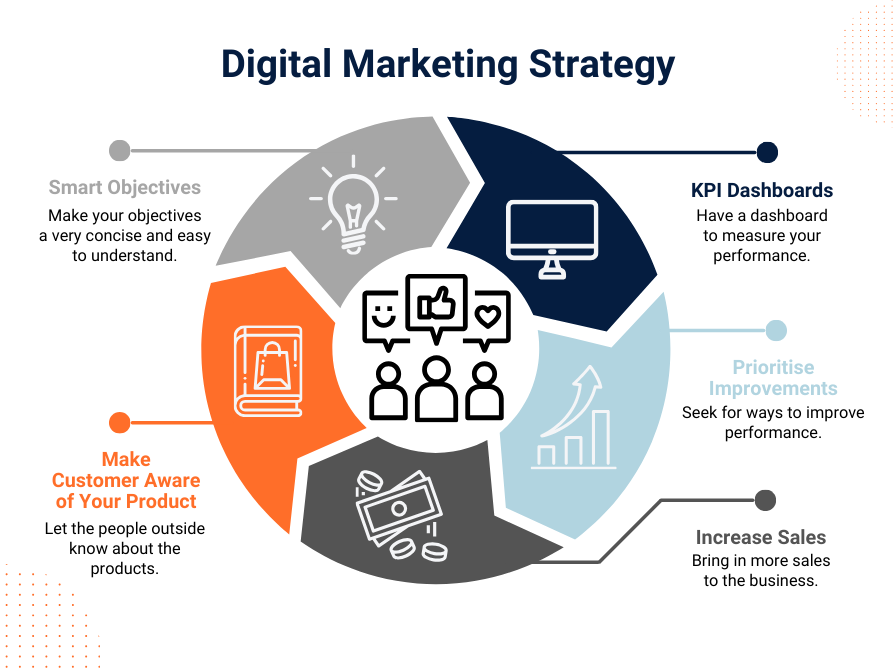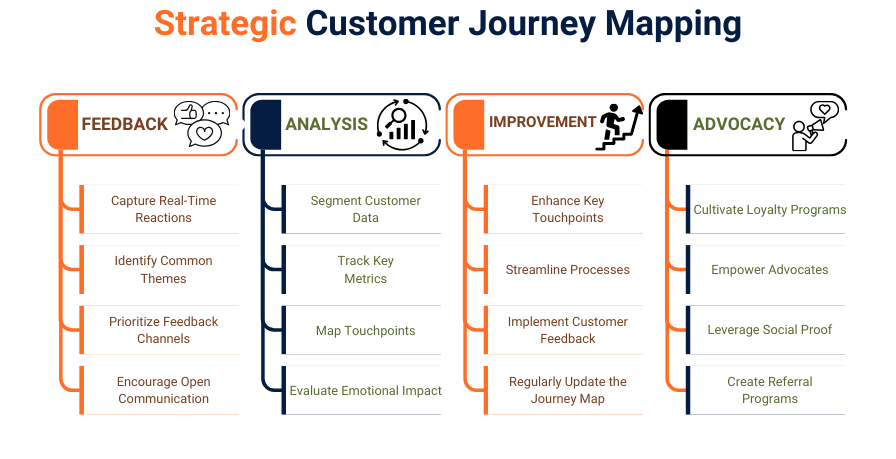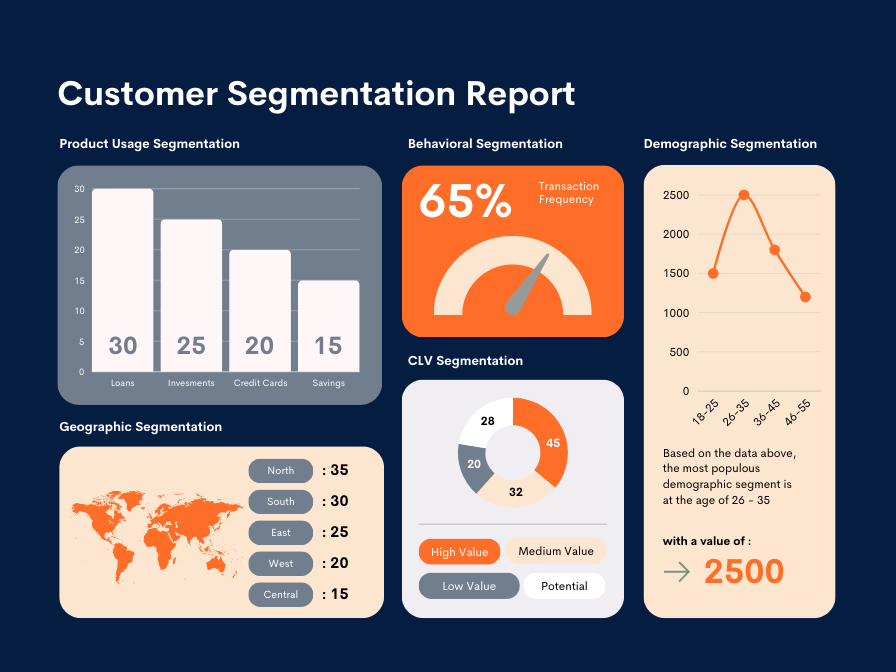Digital customer experience refers to the overall perception a customer has of a brand based on their interactions across digital touchpoints, such as websites, mobile apps, social media, and online services. It encompasses every digital interaction a customer has with the company, shaping their impression of the brand and influencing customer satisfaction, loyalty, and long-term engagement.
Driving digital customer experience strategy is paramount for businesses in today’s digital landscape. Brands must place their customers at the heart of their digital strategy. A well-thought-out and finely constructed digital customer experience strategy not only helps in driving customer satisfaction but also enhances customer loyalty. All this hence creates a robust foundation for driving long-term success.
In our step-by-step guide, we explore a cutting-edge strategy to deliver excellent digital customer experience, keeping businesses competitive. This roadmap could be your success formula to foster deeper, meaningful, and successful connections with your audience. But before we do that let’s understand the three core principles of successful digital customer experience strategy.
Three Core Principles of Successful Digital Customer Experience Strategy
Harvard Business Review defines 3 core principles of Digital Customer Experience, which are as follows:
Define digital experience in context to your business
Most businesses make the mistake of going from top to bottom. What we mean is that if you frame conversion rate as your business objective for digital experience, you may not materialize. Experts from the industry believe that it is rarely the right path to success. Then what is? It is to understand how digital experiences can become growth differentiator for your business. The idea is to focus on solving your pain points and then creating a flow of profits.
Not all customers are equal
Another core principle of creating a successful roadmap for digital customer experience is to recognize that all customers cannot be put on the same pedestal. Divide your customers on the basis of demographics, geographic values. Recognize key parameters that can differentiate your customers- especially high value, and high potential value segments. Personalization should be done appropriately according to this segregation.
Base decisions from the ground up
Continuous improvement is valuable, but it's crucial to think from first principles and consistently reassess and justify your actions and potential alternatives. This approach ensures that the digital roadmap remains prioritized and centered on the most impactful initiatives.

Global e-commerce sales surged over $4 trillion in 2020, marking it as a clear indication that digital shopping has become a habit and is here to stay. By 2023 these behaviors became persistent and global sales reached nearly $5 trillion. Even in the B2B sector, the scenarios have shifted. A study by McKinsey shows that 70% of decision-makers are now willing to spend over $50,000 on new purchases through fully self-serve or remote channels.
The bottom line? Brands must understand that customer behavior and shifts in customer preference is real, crucial, and as essential as it appear. The landscape of business buying is changing rapidly, and embracing these trends can lead to big opportunities.
In the following segment, Valuebound gives you a detailed roadmap of crafting successful digital customer experience strategy.
Step-Wise Roadmap to Successful Digital Customer Experience (CX)
Step 1: Understand Your Customer Base
The first step in crafting a digital customer experience strategy is to understand your customer base. Gather all information and collect data to synthesize information that can be used to create compelling experiences for customers. Data collection through all channels like social media, surveys, analytics, and feedback is the first point to start with.
Identifying customer pain points, preferences, and behaviors is key to personalizing the digital customer experience. Use tools like CRM platforms to track interactions and generate insights.
How to do it: Creating Detailed Customer Personas
A strong digital customer experience strategy starts with detailed customer personas. By segmenting your audience based on demographics, buying behavior, and preferences, businesses can craft more targeted experiences. Personas guide decision-making, ensuring that marketing messages and digital content resonate with the right audience.
Step 2: Map the Customer Journey

Mapping customer journeys can help in visualizing different touchpoints and channels where brands can engage and connect with customers. This is an important step to identify opportunities to improve digital customer experience strategy. Brands must track and chart a map of customer journey from awareness to post-purchase, to make sure that customers receive consistent and seamless experiences across all digital platforms- whether websites or social media.
How to do it: Identifying Key Touchpoints for Optimization
Identifying and optimizing key touchpoints is a core component of any successful digital customer experience strategy. These points could include interactions on your website, app, social channels, or customer service platforms. Each touchpoint presents a chance to improve the digital customer experience, whether through personalized content, faster service, or tailored recommendations.
Step 3: Set Clear Goals and KPIs
To measure the success of your digital customer experience strategy, it is essential to set clear goals and key performance indicators (KPIs). Define what success looks like in terms of customer satisfaction, retention rates, engagement levels, and conversion rates. Regularly assess how well your strategy is achieving these goals and adjust as necessary.
How to do it: Aligning Goals with Business Objectives
Your digital customer experience strategy should align with broader business objectives, such as increasing revenue, expanding market share, or enhancing brand loyalty. Ensure that the customer-centric goals directly contribute to these outcomes, making it easier to justify investment in customer experience initiatives.
Step 4: Cultivate Technology for Personalization & Customer Segmentation

Technology is at the heart of delivering an effective digital customer experience strategy. Utilize AI, data analytics, and machine learning to create personalized experiences. Predictive analytics can forecast customer needs and segmentation, while AI-powered chatbots offer immediate, customized responses.
While personalization tools allow for real-time recommendations, ensuring customers feel understood and valued throughout their journey, segmentation can help you analyze your customers based on product-usage, behavior, geography, demography, and CLV.
How to do it: Choosing the Right Tools for Personalization
Investing in the right technology stack is crucial for implementing a personalized digital customer experience strategy. From content management systems (CMS) to AI-powered analytics platforms, these tools should allow seamless integration and provide actionable insights. Valuebound, for instance, empowers businesses with cutting-edge tools to build tailored customer experiences.
Step 5: Optimize Digital Channels
A strong digital customer experience strategy depends on optimizing all digital channels. Your website, social media profiles, mobile apps, and email campaigns should work cohesively to provide a unified experience. Ensure that each channel is user-friendly, fast, and accessible across devices. Use A/B testing and heat mapping to continuously improve user interactions.
How to do it: Omnichannel Integration for Seamless Experiences
Integrating your channels is essential for a seamless digital customer experience. Customers often switch between devices and platforms, expecting a consistent experience. A cohesive omnichannel approach ensures that whether customers are engaging via mobile, desktop, or in-person, the experience is fluid and satisfying.
Step 6: Continuously Gather and Act on Feedback
No digital customer experience strategy is complete without continuous feedback. Implement feedback loops by using surveys, customer service interactions, and online reviews to assess your strategy’s effectiveness. Ensure that your team acts quickly on negative feedback, turning potential problems into opportunities for improvement.
How to do it: Implementing Feedback Mechanisms for Constant Improvement
Gathering feedback is only the first step; businesses must also be prepared to act on it. Use customer feedback to refine your digital customer experience strategy, whether by adjusting marketing tactics, refining personalization techniques, or improving service quality. This process ensures ongoing alignment with customer needs and preferences.
Step 7: Train Your Team
A customer-centric digital customer experience strategy requires alignment across all departments. Train your team to understand customer expectations and empower them to deliver exceptional experiences. From marketing to sales to customer service, every employee should understand the company’s customer experience goals and how to contribute.
How to do it: Empowering Teams for a Unified Approach
Building a digital customer experience strategy isn’t just about technology—it’s about people. Ensure that your team is equipped with the knowledge, tools, and empowerment needed to support and execute your strategy effectively. Regular training and cross-departmental collaboration can lead to a unified, customer-first approach.
Conclusion: Put Customers at the Heart of Your Digital CX Strategy
Building a successful digital customer experience strategy involves understanding your customers, mapping their journey, setting clear goals, making the right use of technology, optimizing channels, gathering feedback, and training your team.
By following these steps, businesses can create personalized, seamless experiences that not only enhance satisfaction but also drive long-term growth. Valuebound’s expertise in merging cutting-edge technology with human potential allows businesses to excel in crafting superior digital customer experience strategies, ensuring success in today’s competitive marketplace.
Ready to build a powerful digital customer experience strategy? Contact Valuebound today to make full use of cutting-edge technology and deliver personalized, seamless journeys!
FAQs
1. What is a digital customer experience strategy?
A digital customer experience strategy is a comprehensive plan that focuses on improving customer interactions across digital channels, enhancing satisfaction and loyalty.
2. Why is digital customer experience important?
A strong digital customer experience is crucial as it impacts customer satisfaction, engagement, and long-term loyalty, helping businesses stand out in a competitive landscape.
3. What tools can help improve a digital customer experience strategy?
Tools like AI, CRM platforms, and analytics software can help businesses personalize customer experiences, track interactions, and gather insights to enhance strategy.
4. How can businesses personalize the digital customer experience?
Businesses can use data analytics, AI, and predictive insights to offer personalized content, recommendations, and services, creating a tailored experience for each customer.
5. What are the benefits of an omnichannel digital customer experience strategy?
Omnichannel strategies provide seamless, consistent customer experiences across all platforms, improving engagement, satisfaction, and brand loyalty.




